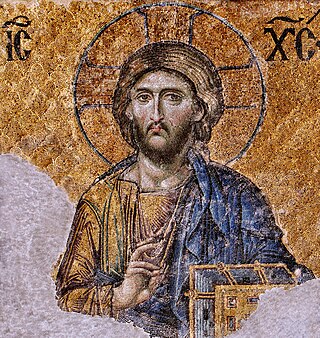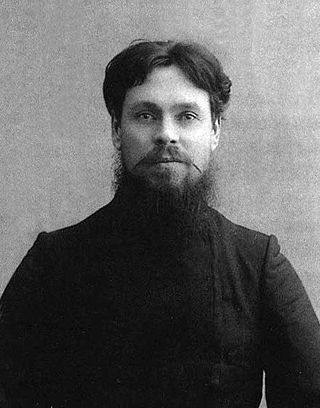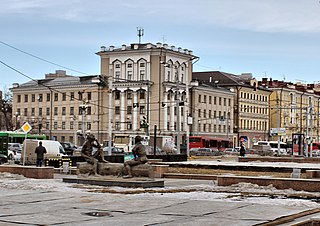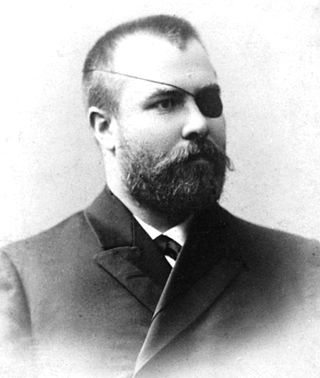
Bespopovtsy are Priestless Old Believers that reject Nikonite priests. They are one of the two major strains of Old Believers.
Oleg Nikolayevich Trubachyov was a Soviet and Russian linguist. A researcher of the etymology of Slavic languages and Slavic onomastics, specialist in historical linguistics and lexicographer. He was a Doctor of Sciences in Philological Sciences, an academician of the Russian Academy of Sciences and served as the editor-in-chief of the Etimologiya yearbook. His works are on the etymology of Slavic languages and on East Slavic onomastics.

Beklemishevskaya Tower is a tower at the Eastern edge of Moscow Kremlin Wall. It was named after a boyar Ivan Bersen-Beklemishev, whose house had been adjacent to the tower from the Kremlin side. It was earlier known as Russian: Москворецкая tower based its position on the near Moskva River. It is similar to the other two towers standing at the other corners of the Kremlin triangle, Vodovzvodnaya and Uglovaya Arsenalnaya rowers. While these towers are cylindrical, all other towers of the Kremlin’s Wall have been built on a square plan base.

Slavic fantasy is a sub-genre of contemporary art that developed in the late 90s and early 2000s. Slavic fantasy is distinguished by the incorporation of Slavic folklore, legends, bylinas, and myths into the general canons of fantasy literature. However, its genre boundaries remain indistinct.

Merílo Právednoye or Just Measure is an Old Russian legal collection from the late 13th or early 14th century, preserved in the copies of the 14th to the 16th centuries. The name was given in modern literature, taken from the first words of this text: "this books is just measure, true weighing...". Just Measure was written in Old Church Slavonic and Old Russian.

Ivan Gavrilovich Blinov was an outstanding Russian calligrapher and miniaturist, bookmaking master, who worked in the traditional manner.

Yuriy Ivanovich Semenov is a Soviet and Russian historian, philosopher, ethnologist, anthropologist, expert on the history of philosophy, history of primitive society, and the theory of knowledge. He is also the original creator of the globally-formation (relay-stadial) concept of world history and is a Doctor of Philosophy, Doctor of Historical Sciences (1963), and Professor.
The Lopukhin family was a noble family of the Russian Empire, forming one of the branches of the Sorokoumova-Glebov family. Eudoxia Lopukhina married Peter the Great. When Pyotr Lopukhin's son died childless, the family's princely title passed to Nikolai Petrovich Demidov-Lopukhin. The present Prince Lopukhin-Demidov is Nikolai Alexander Paul Demidoff born in 1976.
Fedor Maksimovich Putintsev was a Soviet propagandist of atheism and a scientific worker in the study of problems of religion and atheism. He was also a journalist and writer.

Vladimir Schneider is a Russian historian, Doctor of Historical Sciences. He is the author of more than 120 scientific works, among which 6 monographs. He is a professor in the department of universal and national history of Armavir State Pedagogical University. Worked as dean of the history department of ASPU from 1999 to 2011. The main directions of scientific work: the socio-cultural aspect of the history of the peoples of the North Caucasus; Soviet national policy in the North Caucasus of 1917 - the end of the 1950s; the history of the deportations, the stay at the special settlement and the rehabilitation of the North Caucasian peoples; historical and cultural integration processes in the North Caucasus; the history of the German diaspora in the Kuban; historical research methodology issues.
Anatoly Vasilyevich Belov was a Soviet religion scholar and atheist propagandist. He was a First Deputy Chairman of the Council for Religious Affairs under the Council of Ministers of the USSR, an expert on Adventism and one of the authors of the Atheistic Dictionary and Atheist Handbook.

Yunyye Bezbozhniki: zhurnal shkol'nogo bezbozhnogo aktiva was a monthly magazine for schoolchildren, an organ of the Central Committee of the Komsomol, the People's Commissariat of Education of the RSFSR and the Central Soviet of the League of Militant Atheists of the USSR.

The Institute of International Relations is one of the institutes at Kazan Federal University. Its history began with the founding of Kazan Imperial University in 1804. The institute was renamed on September 1, 2018. From 2013 it was called the Institute of International Relations, History and Oriental Studies.
Since its inception in the 18th century and up to the present, it is based on the Cyrillic alphabet to write the Udmurt language. Attempts were also made to use the Latin alphabet to write the Udmurt language. In its modern form, the Udmurt alphabet was approved in 1937.
Music from the Pillar is a short story by Victor Pelevin, published in 1991.

Batlejka is a Belarusian amateur puppet theatre. Its name is derived from the city of Bethlehem and performances are traditionally given over the Christmas period.

Matvey Kuzmich Lyubavsky was a Russian and Soviet historian, professor, academic and rector of the Moscow University from 1911 to 1917.

The employment rate of the Russian population has been quite low since the Soviet era when the birth rate fell, and the number of women involved in the economy rose sharply. After the labor market crisis during the shock therapy of the 1990s, renewed economic growth and a decline in the economically active population of Russia in the 1990s reduced the unemployment rate and increased employment.

The "Circle of Pagan Tradition" ("CPG") is one of the Russian Slavic Native Faith associations.
The Center for Religious Studies in the name of Hieromartyr Irenaeus of Lyons is a Russian non-profit nongovernmental anti-sectarian organization engaged in research and information and consulting work on the activities of new religious movements and sects of a destructive and totalitarian nature.. The Center was established in 1993 with the blessing of Patriarch Alexy II of Moscow and All Russia and has been headed by Alexander Dvorkin since its founding. The Center is the nucleus of the Russian Association of Centers for the Study of Religions and Sects (RACIRS).













